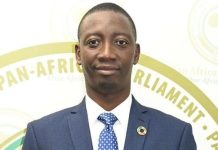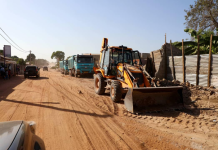By Yankuba Jallow
The Gambia Government has on Thursday, 27th August 2020 launched the NAFA Quick Cash Transfer project to mitigate the social and economic impact of the people.
Vice President Dr. Isatou Touray, who launched the initiative on behalf of the President, said with the advent of the COVID-19 pandemic and the stringent measures put in place by the Government, to prevent and contain the virus, as well as to mitigate its impact on food and nutrition security, the Nafa Program was restructured to contribute to the fight against COVID-19 through a ‘Nafa Quick’.
“The “Nafa Quick” initiative we are launching today is a subset of the Nafa Program that has extended benefits beyond the extreme poor to almost all rural households in the selected districts. The “Nafa Quick” intents to contribute to the mitigation of the social and economic impact of COVID-19 on the population by providing immediate universal cash transfer of D1,500 per month (2 transfers of D3,000) within a period of 4 months to about 83,000 households in 30 districts in WCR, LRR, CRR, URR and NBR covering the lean period,” said the Vice President.
She said the Nafa Program will be implemented in the 20 poorest districts targeting 15,606 extreme poor households for a period of 18 months.
The regular revenue provided to the households through the Nafa Program is aimed at both increasing short-term consumption of essential goods and services, and enabling longer-term investments in human and productive capital.
The Government of The Gambia in collaboration with the World Bank is executing a 5-year US$31 Million Social Safety Net Project.
The project is currently being implemented by the National Nutrition Agency (NaNA), the Social Protection Secretariat, the Department of Community Development and Department of Social Welfare. The project objective is to improve the coordination of social assistance activities, provide temporary social assistance support to rural households in the wake of COVID-19, and increase the inclusion of the extreme poor in the Nafa Program.
It is one of the biggest cash transfers ever in The Gambia as part of the Social Safety Net Project.
Vice President Touray said The Gambia, like many developing countries around the world, has registered much progress in reducing poverty and creating the enabling environment for improving the lives of its people.
The Gambia, in 2015, was ranked 173 out of 188 countries in the UNDP Human Development Index report. The poverty rate remains high in the country with 48 per cent of the population living below the poverty line (US$1.25 a day) and 69.5 per cent of the rural population still considered poor are also battling with food insecurity.
National statistics have indicated that huge disparities exist within The Gambia’s population in accessing basic social protection services, coupled with social, cultural, economic and environmental risks that exacerbate this situation; and those most affected are the poor and vulnerable people.
The Vice President continued: “In recent times, The Gambia has adopted a systemic approach to strengthening Social Protection and working towards the establishment of an integrated and equitable social protection system in the country to better address the needs of the poor and vulnerable people. As a result, social protection issues have taken a center stage in our national and social policy dialogues in The Gambia.”
She said the Government of The Gambia has also demonstrated staunch commitment to make Social Protection issues a national priority by coming up with a National Social Protection Policy as envisaged in the NDP 2018-2021. She added that the Government is also spearheading a number of policy level initiatives including the annual National Social Policy Forum and the establishment of the National Social Protection Steering Committee (NSPSC), mandated to promote high level dialogue for improved social protection delivery.
She said the National Social Protection Steering Committee provides oversight, coordination and advocacy for inclusive social protection in the country, adding the Committee has recently been revitalized under her chairpersonship.
The country’s number two said component 1 of the project focuses on the Development of Co-ordination Mechanisms for the Social Assistance Sector and Component 2 focuses on the “Nafa” Program of Cash Transfers and Social and Behavioral Change Communication (SBCC) to the Eligible Extreme Poor and Component 3 focuses on Project Management and Capacity Building.
The former activist against harmful traditional practices against women said the coordination of the social assistance sector is being improved and supported by maintaining a Social Registry and establishing a Social Protection Secretariat.
These efforts would contribute towards the Government’s goal of establishing and strengthening the leadership, coordination and implementation mechanisms of Social Protection initiatives in the country.
She said The Nafa Program will provide cash transfer targeting the extreme poor households with accompanying Social and Behavioural Change Communication (SBCC). This will contribute towards the Government’s goal to increase social assistance coverage of the extreme poor.
She explained that: ”the Nafa Program targets specific geographical areas, the selection of which started at district level. This exercise was informed by the district contribution to poverty in The Gambia, measured by the sum of the extreme poverty headcount ranking and the extreme poverty gap ranking.”
She detailed that the rationale behind starting the selection at district level was based on the huge differences in poverty levels within regions, which results in better-off and more populated areas masking important poverty pockets, which often remain neglected by several program interventions.
“Using the Integrated Household Survey 2015/16 data, districts with the highest ranking by head count poverty rate plus poverty gap rate were selected. Within each of these districts, all communities, and all the households within, will be assessed for eligibility,” the VP said.
She said the program is designed to provide continuity and harmonization with other programs, by taking an existing package of cash transfers with Social and Behavioural Change Communication managed by partners to new districts and regions.
“However, Nafa Program differs from other programs in that the targeting is based on poverty status rather than categorical selection, the beneficiary unit is the household instead of the individual, and the Social and Behavioural Change Communication interventions will cover productive capital as well as human capital topics,” she said.




















